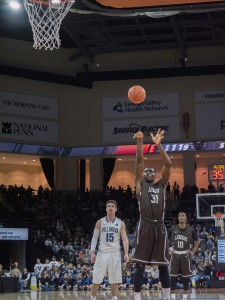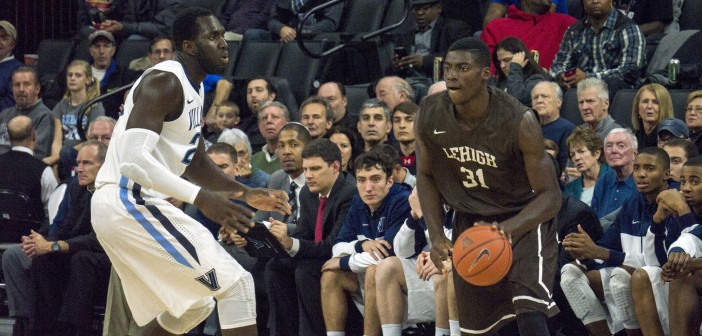
Junior forward Jesse Chuku attempts a foul shot against Villanova Univeristy at the PPL Center on Friday, Nov. 14, 2014. The PPL Center is one venue that has been discussed as a potential host for a neutral-site tournament. (Chris Barry/B&W photo)
One of the most delicate aspects of a basketball conference is the representation of its conference tournament, which is often the way that the conference is represented nationally.
This year’s Patriot League Tournament resulted in the fourth seeded Lafayette College prevailing over sixth seeded American University in the finals. As had been the case in previous years, Lafayette hosted the game in its own gym because it is the higher seeded team.
However, there are yearly discussions about whether the conference should consider the format adopted by most other Division I Conferences, which is holding each round of its tournament at a neutral site.
“There has been considerable discussion around this point,” coach Brett Reed said. “Our league is proactive in trying to create the best tournament environment for the needs of our teams. Finding a neutral site has been discussed but even after taking site visits by our league administration, the suggestion has been to remain at campus sites.”
There are two sides to this issue. One side wants to replicate a better “tournament” atmosphere, and feels that the best way of doing so is holding games at a neutral site. The other side feels that it is most important to continue the current format, since it rewards teams that do better in the regular season by giving them the right to play tournament games in front of a home crowd.
Still, even with the two sides, coaches and players seem to primarily be voicing concerns about fairness of competition in a potential neutral site tournament.
“Really, you are fighting to get that home court advantage,” junior forward Jesse Chuku said. “So I feel like teams towards the bottom of the league might slow down, rest a little bit, because they won’t see the point.”
Chuku added that having the games at a neutral site will give an advantage to schools who have the strongest transportation systems for sporting events, as those schools could draw a strong crowd regardless of the location of the venue. Many schools in the Patriot League may lag behind others in that area.
Economics is another big obstacle preventing the league from looking further into making a change. The Patriot League, under its current format of hosting on the home court of the higher seed, has done well as far as being able to reimburse costs. According to the Lehigh Director of Athletics Joe Sterrett, while there have been few years where the league could reimburse all of its costs, most years, the league has been able to reimburse over 75 percent, which is a very healthy number.
“We know we are going to have a positive net,” Sterrett said. “It’s a question of how big that net is going to be and how much of the cost that it will cover, and that’s a function of your matchups.”
In fact, the Patriot League can even compare current numbers to its own data from when it hosted neutral site basketball tournaments, since this actually happened up until 2002. From its first year carrying basketball until 1998, it hosted each of its games at a predetermined neutral site, which was always the home gym of one member of the league. Then, from 1999 to 2002, the tournament was held at the Showplace Arena in Upper Marlboro, Maryland. With a capacity of 5,000, it was still slightly bigger than many Patriot League arenas, but still paled in comparison with Lehigh’s Stabler Arena, which can hold 6,000. Also, the Showplace Arena was originally designed for equestrian rather than basketball.
In fact, Sterrett did not paint a pretty picture when discussing finances in the 12 years of having the event at a neutral site. The Patriot League was able to reimburse over 50 percent of its tournament costs in only three of these years.
With all of this considered, coaches and administrators feel that the conference is in a good place right now and has a tournament that has desired effects. When games are on the home court of higher seeds, that slightly lessens the chance of an upset, which improves the odds of the Patriot League getting its strongest, or one of its strongest members, into the NCAA Tournament.
“Our league has really sought to protect the highest seeds that are earned from regular season play,” Reed said. “The philosophy is that the Patriot League wants their strongest teams representing us in the NCAA tournament. Having games on home sites for the highest seeds helps to promote that this happens.”
Despite a lot of discussion, The Patriot League sees the current format as the most viable one, at least for the foreseeable future.
“If it doesn’t make economic sense and it leads to more upsets, then I don’t know if in our league that that’s a good thing,” Sterrett said. “I think in our league, what has happened is the regular season takes on a lot of significance because you’re playing for seeds.”






Comment policy
Comments posted to The Brown and White website are reviewed by a moderator before being approved. Incendiary speech or harassing language, including comments targeted at individuals, may be deemed unacceptable and not published. Spam and other soliciting will also be declined.
The Brown and White also reserves the right to not publish entirely anonymous comments.